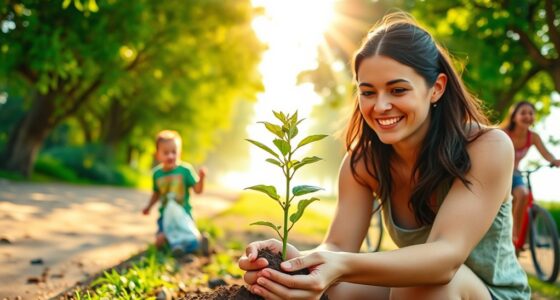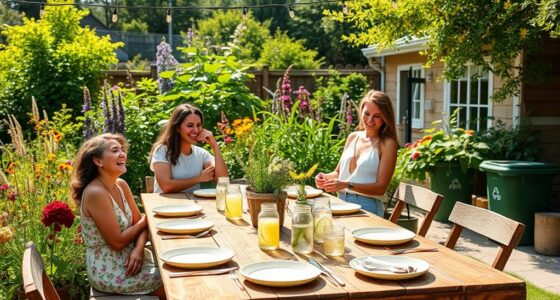Looking for DIY eco-friendly summer crafts? You can capture rainwater for your garden with a rain barrel or regrow vegetables from kitchen scraps. Create a nutrient-rich compost bin or upcycle Mason jars into oil candles for warm evenings. Transform plastic bottles into planters, whip up natural bug spray, and decorate pinecones for a touch of sparkle. Finally, make recycled seed paper that grows! There are plenty more projects waiting for you to explore.
Key Takeaways
- Create upcycled Mason jar oil candles for ambient summer evenings using vegetable oil for a clean burn and personalized fragrance.
- Transform plastic bottles into fun self-watering planters for herbs and flowers, engaging kids in recycling education.
- Make bedazzled pinecones as eco-friendly decor by painting and adding glitter, perfect for summer displays.
- Use natural materials for all-natural tie dye, incorporating earth pigments and upcycled clothing for unique designs.
- Craft recycled seed paper for summer cards or invitations, promoting biodiversity with wildflower or vegetable seeds.
Rain Barrel: Capture Rainwater for Your Garden
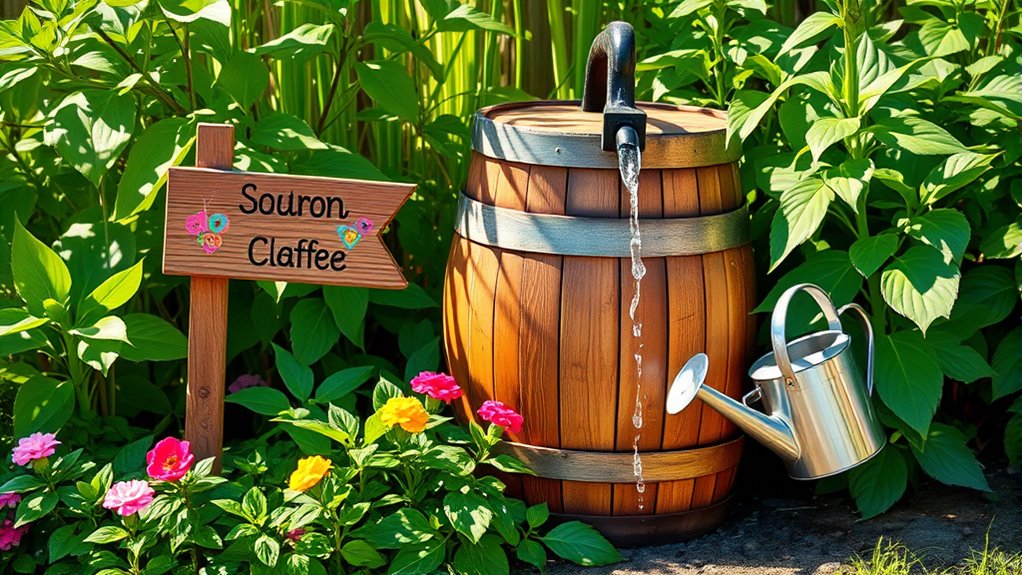
Installing a rain barrel can be a simple yet effective way to capture rainwater for your garden. It helps you conserve water, reduces your water bills, and lessens the environmental impact by decreasing stormwater runoff. Plus, it’s a cost-effective solution that can be easily built or purchased. You can use collected rainwater for various tasks, like washing your car or filling birdbaths. To get started, you’ll need a food-grade barrel, a faucet, an overflow system, and a screen to keep debris out. Elevate the barrel using cinder blocks for better water pressure. Additionally, using rainwater is beneficial for your garden as it lacks chlorine and is free. Regular maintenance, like cleaning the barrel and checking the screen, ensures your rain barrel remains functional and efficient throughout the seasons, while promoting sustainable energy practices that can enhance your overall eco-friendly efforts. Integrating rainwater harvesting with solar energy solutions can further amplify your efforts towards sustainable gardening. In addition to capturing rainwater, implementing energy-efficient models can reduce your overall consumption and enhance your garden’s sustainability.
Kitchen Scrap Garden: Regrow Your Vegetables
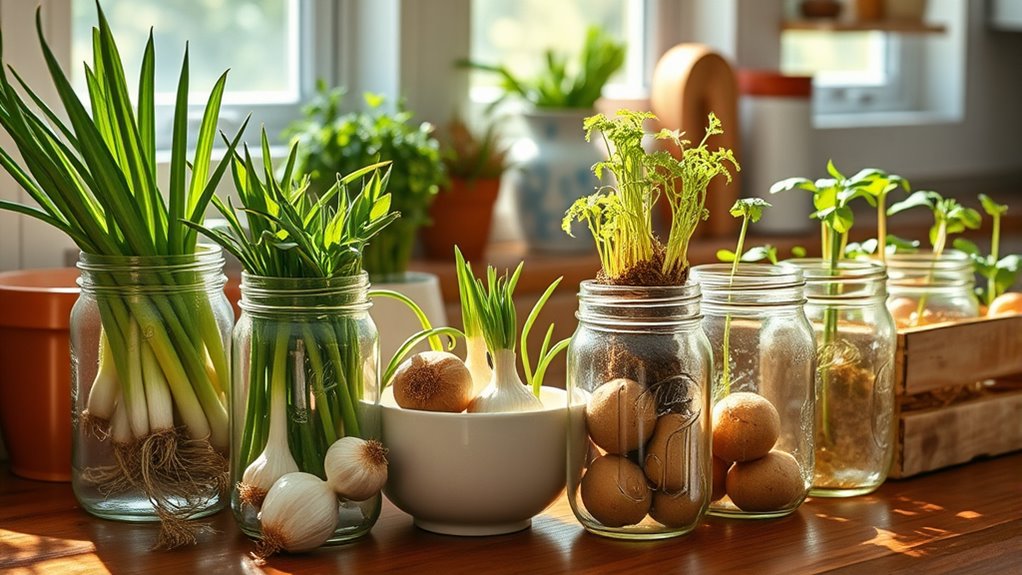
If you want to embrace sustainability while enjoying the fruits of your labor, starting a kitchen scrap garden is a fantastic choice. Regrowing vegetables from scraps not only reduces food waste but also promotes eco-friendly practices. You can easily regrow green onions, celery, and lettuce in water, requiring little more than a jar and some sunlight. Regularly maintaining your kitchen scrap garden can also support a healthier lifestyle by encouraging fresh produce consumption. Incorporating whole foods into your diet, such as the fresh vegetables you grow, can greatly enhance your overall nutrition. Additionally, creating a small backyard greenhouse can extend your growing season, allowing you to cultivate even more plants year-round. Herbs like basil and mint thrive in similar conditions, offering fresh flavors for your meals. Just remember to change the water daily to keep roots healthy. This fun and educational project teaches you about plant biology while providing quick results. Plus, you’ll be amazed at how many scraps can turn into vibrant plants, making your kitchen truly zero-waste! Additionally, consider regrowing green onion scraps, as they are particularly easy and quick to cultivate in water.
DIY Compost Bin: Create Nutrient-Rich Fertilizer

Creating your own DIY compost bin is a rewarding way to turn kitchen scraps and yard waste into nutrient-rich fertilizer for your garden. You’ll need materials like lumber, hardware cloth, and screws, and tools such as a saw and power drill. Consider designs like a wooden bin for stability or a pallet compost bin for affordability. One effective design is a 3-bay compost system, which allows for the rotation and turning of compost to enhance decomposition. Regular grooming of your pets can help reduce the amount of pet hair that might otherwise contaminate your compost materials. Additionally, incorporating nutritional guidance into your gardening practices can lead to healthier plant growth. Using unique planter designs can also help you create a visually appealing and functional garden space. Start by layering brown materials like dried leaves and green materials such as food scraps. Keep it damp but not soggy, and turn the compost regularly to speed up decomposition. In about 6 to 8 weeks, you’ll notice your compost is ready, with an earthy smell and dark texture. Use it to enrich your garden beds and enjoy healthier plants!
Upcycled Mason Jar Oil Candles for Summer Evenings

After enriching your garden with homemade compost, you can brighten up your summer evenings with charming upcycled Mason jar oil candles. Start by filling your jars with decorative elements like cranberries or orange slices, then add a layer of vegetable oil—olive oil works best for a clean burn. Insert a floating wick, using a skewer or pencil to arrange it, and if you like, add a few drops of essential oils for fragrance. These eco-friendly candles burn longer and produce minimal smoke, making them perfect for outdoor gatherings. Additionally, using scented mason jar candles allows you to create a personalized aroma that enhances the ambiance. Moreover, adding soluble fiber from chia seeds to your summer snacks provides a healthy source of omega-3s. Remember that using drainage features in your candle designs can help avoid spills and ensure a safer experience. Keep them away from flammable materials and never leave them unattended. Enjoy the ambiance while contributing to a more sustainable lifestyle!
Plastic Bottle Planters: A Fun Way to Reduce Waste

While summer brings vibrant colors and warm weather, it also offers a perfect opportunity to get creative with waste reduction through DIY projects. One fun way to do this is by transforming plastic bottles into planters. Start by cutting the bottles and removing labels. Clean them thoroughly, then add drainage holes. You can paint or decorate the bottles to make them eye-catching. Building a self-watering planter is an innovative twist on this project that enhances growth while minimizing maintenance. Additionally, using well-seasoned wood as a natural material for outdoor decor can further promote eco-friendliness in your garden. Embracing the beauty of home and heritage through such projects can create a sense of connection with the environment.
Incorporating plants into your space can also contribute to a holistic lifestyle that emphasizes well-being and sustainability. Fill them with potting soil and plant easy-care options like succulents, herbs, or flowers. This project not only reduces waste but also teaches the importance of recycling. Plus, it’s a great way to engage kids in environmental practices.
Natural Bug Spray: Eco-Friendly Insect Repellent

As summer days invite you outdoors, protecting yourself from pesky insects becomes essential. Natural bug sprays offer a non-toxic alternative to chemical-laden products, reducing your exposure to harmful substances. By using biodegradable ingredients, you’re also helping to protect the environment from pollution. Plus, you can customize your spray to fit your preferences, choosing scents like lemon eucalyptus or lavender, which are known for their repellent properties. Additionally, using natural ingredients can enhance your overall health and well-being. Always ensure to dilute oils properly before applying them to your skin for safety.
For a simple skin spray, mix one part lemon eucalyptus or lavender oil with ten parts witch hazel. Moreover, portable camping toilets can provide comfort and convenience during your outdoor adventures, ensuring that you can enjoy nature without the worry of inadequate facilities. Additionally, certain natural ingredients like citronella and peppermint oils have been recognized for their effectiveness in repelling insects. For your home, combine lavender, lemon eucalyptus, and citronella oils with distilled water and white vinegar. These DIY options not only keep bugs away but also promote a healthier lifestyle and a greener planet.
Bedazzled Pinecones: Sparkle From Nature
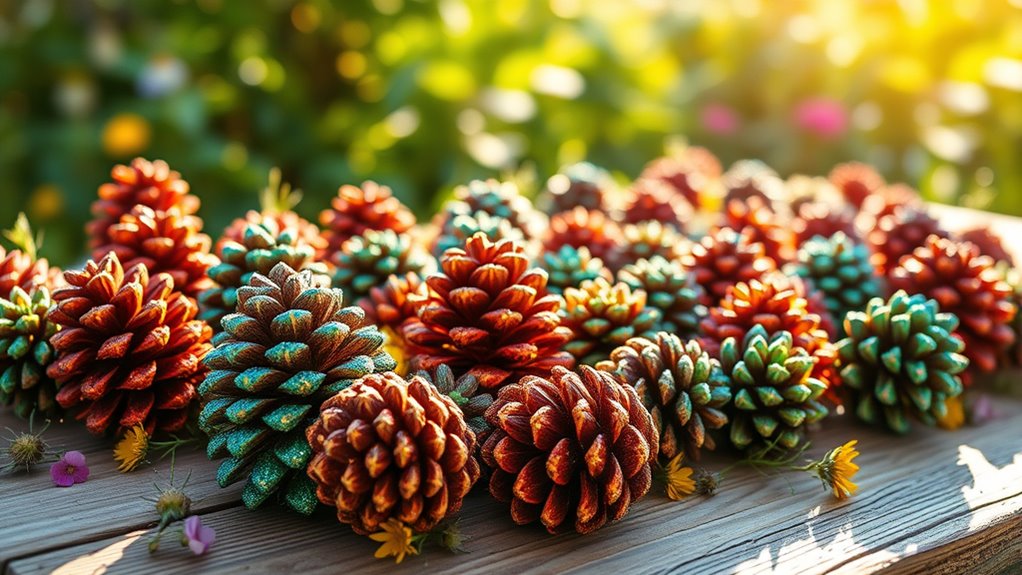
Transforming ordinary pinecones into dazzling decor is a fun and eco-friendly summer project you can easily tackle. Start by baking your pinecones at 225°F for 15 minutes to eliminate sap and insects. Gather your crafting essentials: acrylic craft paints, glitter, hot glue, wooden stars, empty thread spools, and washi tape. Use a paper plate for painting to keep your workspace tidy.
Once painted, sprinkle glitter while the paint’s wet or shake it in a plastic bag for even coverage. You can even add beads to mimic festive lights! To enhance your pinecone decorations, consider adding small wooden stars to the tops for a charming finish. Additionally, this project promotes sustainable crafting by utilizing natural materials that are free and reusable. The use of natural materials in projects like this aligns perfectly with the modern farmhouse decor trend focused on eco-friendly choices. Incorporating natural elements into your decor not only enhances aesthetics but also promotes tranquility in your living space.
Display your creations on your mantel or in cloches for stunning centerpieces. Remember, pinecones are natural and free, making them a perfect sustainable crafting choice!
Recycled Seed Paper: Plantable Art
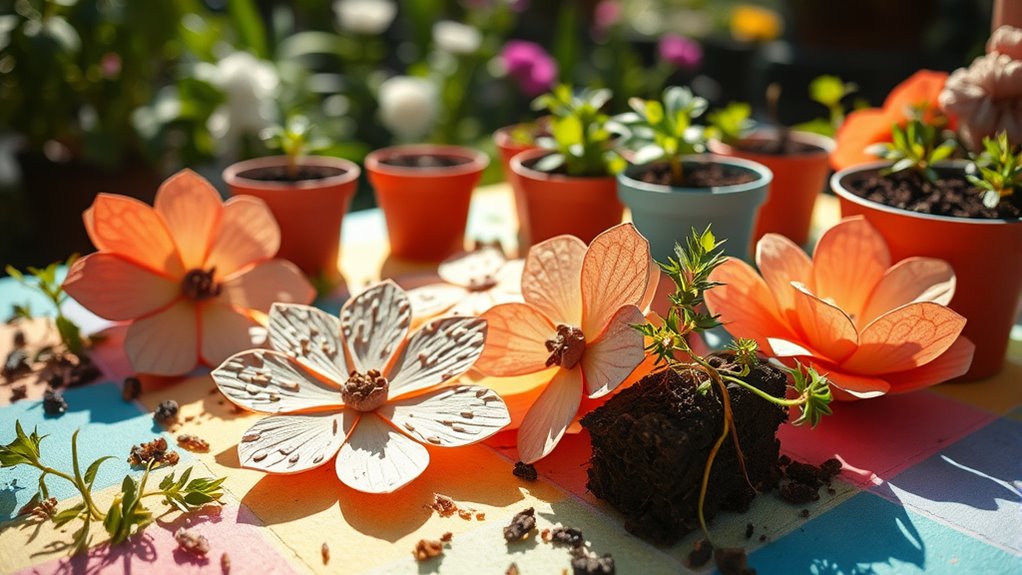
After creating stunning bedazzled pinecones, it’s time to explore another exciting eco-friendly project: recycled seed paper.
Gather your materials, including recycled paper like newspaper or used printer paper, and soak them in water overnight. Once the paper is soft, blend it with water to create a pulp. Notably, you can make seed paper using various types of paper to achieve different textures. This project is a fantastic way to engage with sustainable gardening practices while promoting biodiversity. Additionally, using native seeds can enhance local ecosystems and attract beneficial insects, making it a great way to support local wildlife in your area.
Stir in your choice of seeds—wildflower or vegetable seeds work great! Spread the pulp on a flat surface covered with towels and let it dry.
You can shape your paper using simple cookie sheets or molds. This plantable art not only promotes recycling but also supports local wildlife when you plant it.
Use your seed paper for cards, invitations, or bookmarks, and watch your creations grow!
All Natural Tie Dye: Sustainable Clothing Craft
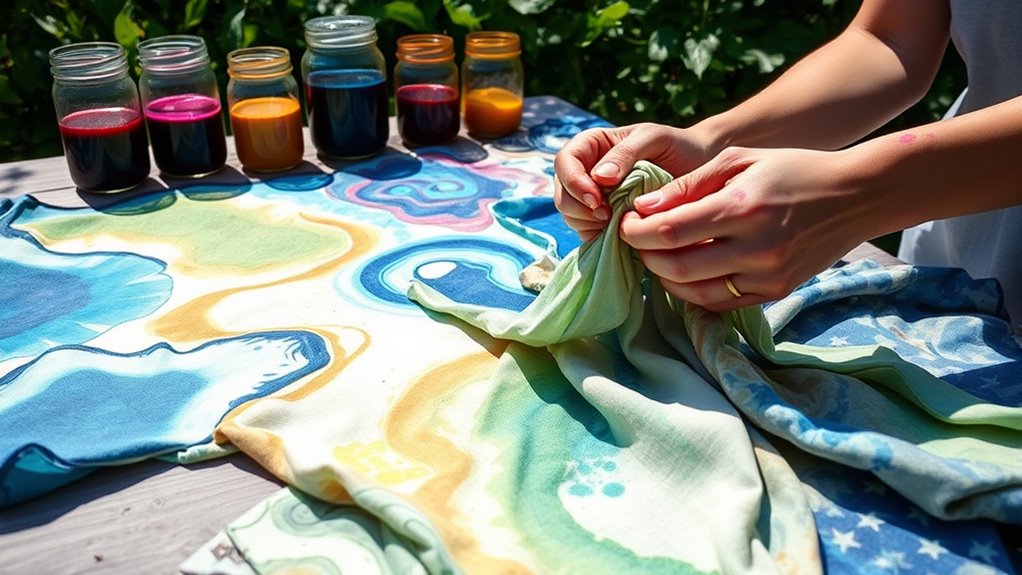
If you’re looking for a creative way to refresh your wardrobe while staying eco-friendly, all-natural tie dye is a fantastic option. You can use earth and mineral pigments, soy milk binders, and vibrant colors from fruits and vegetables like avocado pits and beets. Creating soy milk binder is essential for ensuring the fabric absorbs the dye effectively, enhancing the overall color vibrancy.
Natural fabrics such as cotton or bamboo work best, retaining dyes effectively. To minimize water usage, try working in small batches and upcycle old clothes into unique pieces. This method avoids toxic chemicals, promoting a healthier environment for you and local communities.
Experiment with different plants for unique designs and patterns inspired by nature. Join workshops to learn sustainable techniques and connect with local artists, fostering a love for eco-friendly fashion.
Frequently Asked Questions
What Materials Can I Use for Making a Rain Barrel?
To make a rain barrel, you’ll need a few key materials. Start with a plastic container like a garbage can or a 55-gallon drum.
You’ll also need lead-free hose bibs for water control, rubber O-rings for sealing, and silicone caulk for waterproofing.
Consider using cinder blocks or wooden stands for elevation.
Don’t forget flexible downspout adapters, overflow valves, and tools like a drill and caulk gun to assemble everything securely.
How Do I Store Kitchen Scraps for Composting?
You’ve got a mountain of kitchen scraps and nowhere to put them! Don’t panic! You can store them in countertop bins with tight seals or even freeze them in bags to curb odors.
If you prefer hiding them away, under-sink containers are perfect. For a sleek look, consider custom pull-out compost bins.
With these options, you’ll keep your kitchen tidy while making a fantastic compost for your garden!
Can I Use Any Type of Plastic Bottle for Planters?
You can’t use just any type of plastic bottle for planters. PET and PVC bottles can leach harmful chemicals into the soil, making them unsuitable, especially for edible plants.
Instead, opt for HDPE or LDPE bottles, as they’re safer and less likely to release toxins. Always clean the bottles thoroughly before use, and consider creating self-watering planters or seed starters to maximize your gardening experience while being mindful of safety and sustainability.
How Do I Make Homemade Natural Bug Spray Effective?
To make your homemade natural bug spray effective, blend essential oils like citronella and eucalyptus with witch hazel or vodka as a base.
These ingredients help the oils mix with water and boost their potency. Always shake the mixture before use to ensure everything’s well combined.
What Are Some Safe Dyes for All Natural Tie Dye?
For safe dyes for all-natural tie-dye, consider using fruits and vegetables like beets for pink and carrots for yellow.
Herbs like turmeric can give you vibrant yellows, while black beans create blue shades.
You can also explore earth pigments mixed with a binder, like soy milk, for a range of colors.
Always remember to use natural fibers like cotton or silk for the best results.
Enjoy experimenting with your colorful creations!
Conclusion
By diving into these eco-friendly summer crafts, you’re not just having fun—you’re making a positive impact on the planet. Each project, from creating a rain barrel to upcycling mason jars, helps reduce waste and promotes sustainability. So, why not unleash your creativity while caring for the Earth? As you enjoy the warm weather, remember that every small effort counts. Get started today, and watch how your simple crafts can lead to a greener tomorrow!



